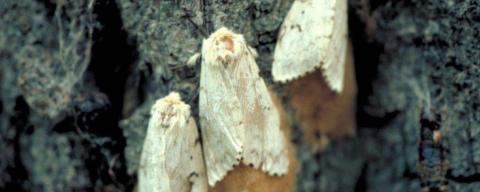Introduction
The spongy moth (Lymantria dispar), adopted as a new common name is an important defoliating insect of hardwoods in New Hampshire. A native of Europe and Asia, the spongy moth was introduced into North America in 1869 when specimens were accidentally released in Medford, Massachusetts. Spongy moth is an outbreak pest and can remain at low levels for several years and then numbers can rise every few years. Unless areas are actively monitored even moderate populations can exist unnoticed. Although these cycles are influenced by numerous factors, the low populations in New Hampshire in recent years generally are believed to be the result, at least in part, of a disease caused by the fungus, Entomophaga maimaiga.
The spongy moth is an important defoliating insect of hardwoods in New Hampshire.
Description
Adults: Females are mostly white with a wingspread of 2”; males are light tan to dark brown with a wingspread of 1½”. Females are flightless; males are good fliers and are often seen flying about in large numbers. Moths are found from early July through August. They do not feed on foliage.
Eggs: Egg masses are buff-colored, velvet-textured, and 1½” by ¾”. Clusters are mostly deposited on tree trunks and branches, but can also be found on stone walls, furniture, houses, and cars.
Larvae: CCaterpillars are brown-black and hairy, with six pairs of red dots and five pairs of blue dots on the back when mature. Full-grown larvae are 2” long.
Pupae: Pupae are dark brown and shaped like a conical cylinders ¾ to 1½” long. They attach to many objects including trees, buildings, rocks, and logs.

Life Cycle
The female moth deposits her egg mass of 300-500 eggs in July- August. The eggs overwinter on trees, rocks, stumps, in crevices, and
on buildings. The eggs hatch in May and tiny larvae (caterpillars) spin fine silken threads which help them wind-disperse.
The larvae mainly feed at night and crawl down trees to seek shade during the day. They feed until late-June or early-July and pupate. In 10-14 days, adult moths emerge from the pupal stage. The male moths fly to the flightless females, usually on tree trunks, and mate.
The females deposit egg masses shortly after mating. There is only one generation per year. After several years of defoliation, the population collapses, usually due to a viral disease. It will then remain at low levels until populations build and erupt again. In New Hampshire, outbreaks have occurred on average every 7 to 10 years since 1924. Nowadays, the outbreaks are more localized than widespread.

Damage
Mortality: Spongy moth caterpillars prefer oaks, apples, birches, poplars, and willows. Less preferred species are ashes, maples, cherries, elms, beeches, and softwoods. Caterpillars will feed on many kinds of plants once the preferred trees in an area or stand are defoliated.
Defoliation, and hence growth loss and tree mortality, are directly related to the percent of oak (the preferred host) in the stand. Though pure stands of softwoods are practically immune to defoliation, hemlocks and pines are especially vulnerable to mortality when mixed with oaks. Suppressed softwoods, often in the under story of hardwood stands, are much more likely to die than dominant trees. Over story pines often escape complete defoliation and survive. Softwoods like hemlocks and pines are more likely to die after a single defoliation than hardwoods. It takes softwoods several years to grow a full complement of needles, whereas hardwoods grow a full crown of leaves each year.
Healthy hardwoods generally require two or more years of heavy defoliation (61-100%) before they are killed. Defoliation weakens trees and increases the likelihood of attacks by fungi and other insects (secondary invaders). Hardwoods with more than 50% defoliation will usually re-foliate before fall. This new flush of leaves uses most of the food reserves necessary for growth the following year. Defoliated trees enter dormancy later, and are thus more prone to winter injury. Bad weather (especially drought), poor soil type, and low tree vigor also lead to tree mortality. As a result, trees may not die until years after defoliation. Among the hardwoods, oaks receive the greatest mortality because they are the preferred host and suffer the most defoliation. Do not remove defoliated plants unless they fail to leaf out in the spring following defoliation.
Oak mortality after heavy defoliation depends on crown condition, crown position in the forest canopy, and species, in that order. Suppressed trees with small or sparse crowns are more likely to die than large, full crowned dominant trees. Chestnut oaks, black oaks, and white oaks are more likely to die than red oaks. NH red oaks tend to be resilient, perhaps because repeated outbreaks lead to natural selection of resistant trees. In a study by the author after the 1981 outbreak, average red oak mortality for trees with a diameter at breast height (DBH) of 10” or greater was only 6%. However, this is an average and some stands received greater mortality. Better sites sometimes have higher mortality because they often have more insects and diseases to act as secondary invaders. Also, dry, shallow sites, “select” for hardy trees that are more capable of withstanding defoliation.
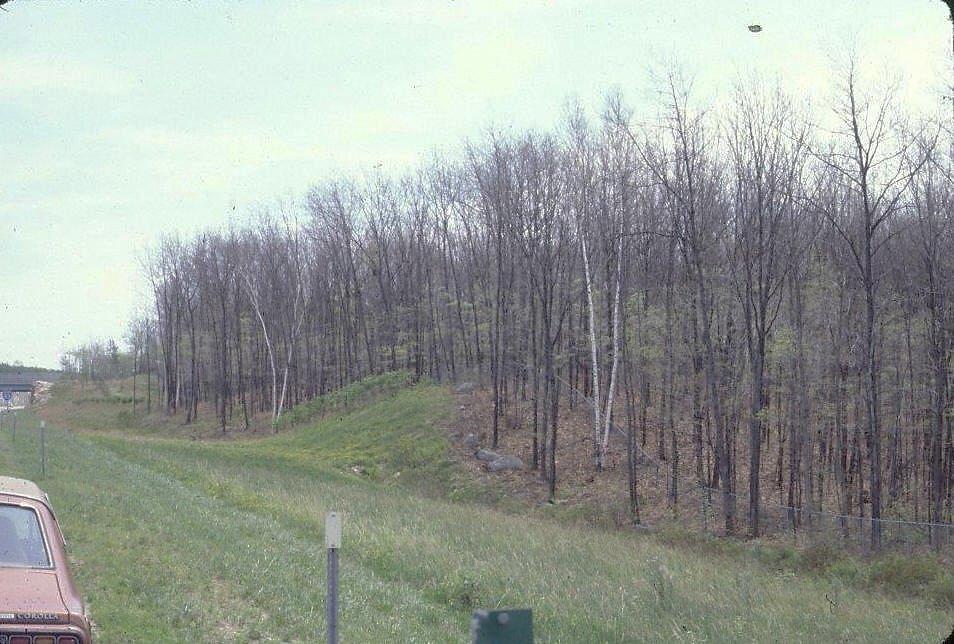
late June, 1980. Credit: Alan T. Eaton.
Growth Loss: In a typical outbreak cycle in New Hampshire, a susceptible oak stand will receive one year of light (1-30%) to moderate (31-30%) defoliation and 1-2 years of heavy defoliation (61-100%). Based on our studies, the first year of light defoliation reduces annual growth an average of 29%; the first year moderate defoliation reduced growth about 40%; in the second year (heavy defoliation) growth is reduced about 50%; in the third year (heavy defoliation) growth is reduced 75% compared to “normal” pre-defoliation growth rates. After the outbreak, trees will increase annual growth during each year of the recovery until normal growth rates are attained. Healthy stands recover to normal growth within 2-3 years after the last defoliation. Highly stressed stands may take up to 10 years to recover.
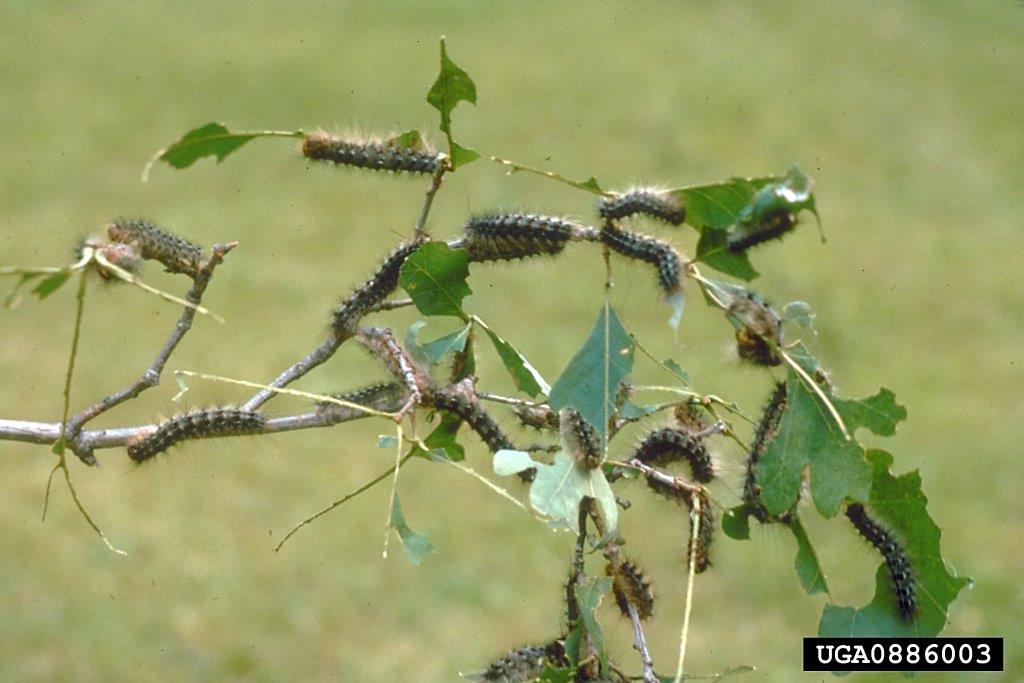
Bugwood.org.
Acorn Production: Even light defoliation of oaks can substantially reduce acorn (mast) production. Spongy moth outbreaks thus have a negative impact on New Hampshire’s woodland wildlife, as many birds and mammals (turkey and deer, for example) depend on this fall food source. Lack of acorn production will also delay natural regeneration of oak seedlings.
,%20Lee,%20bugwood,%205433067-LGPT.jpg)
Reduction of Timber Value: Even though the Spongy moth may not kill a tree, defoliation often reduces timber value by causing epicormic branching (sprouting), wood stains, and increased secondary insect damage (ambrosia beetles and wood borers). Various decay fungi also readily invade weakened or damaged trees, diminishing timber value.
DID YOU KNOW: The fungus Entomophaga maimaiga has been helping keep spongy moths in check.
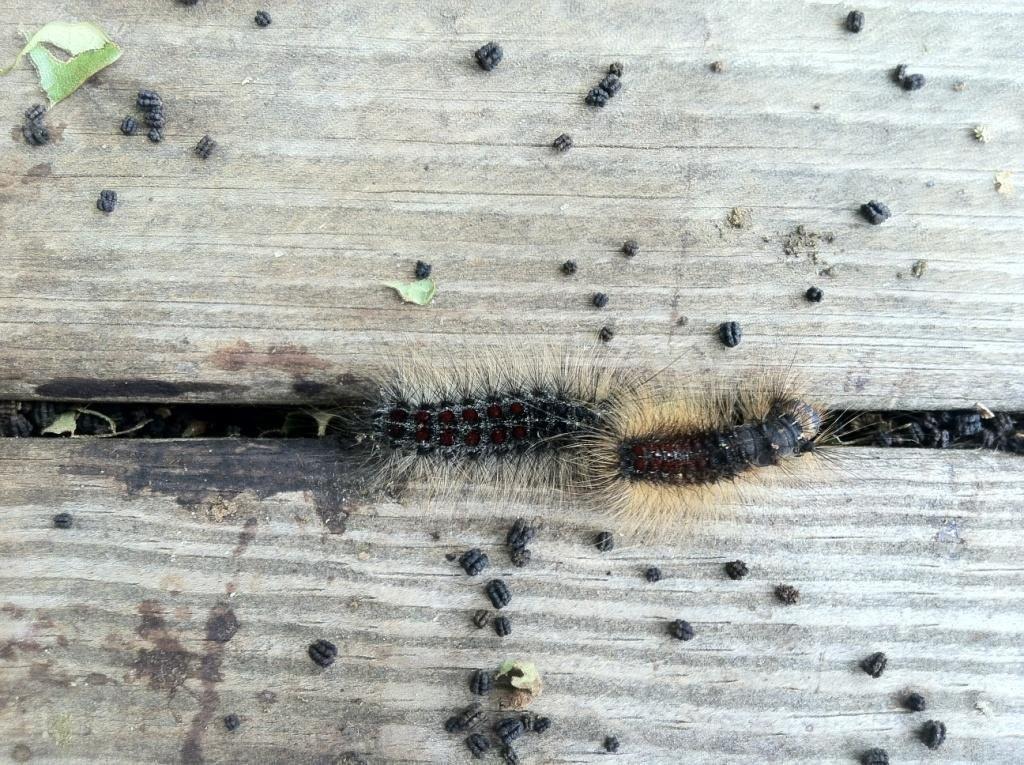
Diagnosing the Problem
Practical Technique for Woodlots: The easiest method to determine likely defoliation is the ten-minute egg mass count. Take a five-minute walk into the woods and follow a straight line for about 500 feet counting visible fresh egg masses on tree boles. Then walk back to where you started. Average the counts from your two five-minute walks. If tthe average of the two counts is 12, there are about 250 egg masses per acre, and light defoliation is expected. An average count of 50 equals about 1,000 egg masses per acre, forecasting heavy defoliation. Factors such as species composition, human error, and egg mass size contribute to the imprecision of this technique. However, the ten-minute walk will quickly determine which stands are at high risk. Egg mass surveys should be done in the fall when leaves are off the trees, making egg masses more visible. By late winter, even new egg masses are weathered and indistinguishable from old egg masses.
Impractical Technique for Woodlots: Pheromone traps are useful as a monitoring tool for tracking moth populations from year to year. These traps use a sex lure to trap male moths. By the time male moths are flying, however, defoliation has already occurred. Also, these traps cannot capture enough male moths to reduce the number of egg masses for the next year. They may increase the number of male moths in an area.
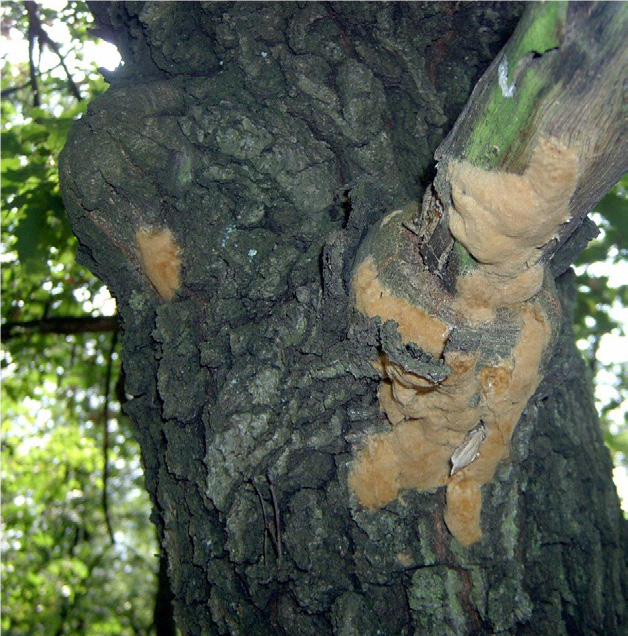
University of Suceava, Bugwood.org.
Biological Control
Parasites and predators are active throughout the spongy moth life cycle. Enemies include rodents, birds, parasitic wasps, spiders, ground beetles, fungi, and viruses. Although they may destroy many insects, none of these natural predators can prevent a spongy moth outbreak. However, they help maintain populations at low levels, and lengthen the time between outbreaks.
Once the outbreak has peaked, starving caterpillars are quickly killed by wilt disease. Virus-infected larvae are shiny and hang limply in an inverted “V” position. Their skin is fragile and will rupture easily, emitting a brownish, foul-smelling liquid.
Entomophaga maimaiga, a fungus that attacks spongy moth larvae, was imported from Japan and released in Boston as a possible control in 1910 and 1911. The experiment seemed to have failed, since extensive surveys found no evidence of its survival. Then, in 1989, scientists discovered the fungus in dead spongy moth larvae in New Hampshire, Vermont, and Connecticut. Today, E. maimaiga is considered an important part of the natural arsenal that helps keep spongy moth populations in check.
Occasionally, weather affects spongy moth. Prolonged, extreme cold (-26F) will kill most egg masses. Wet, cold springs are detrimental to larvae. Drought (May through early July) limits the ability of the fungus to kill the larvae.

Larvae infested with virus. Credits: John H. Ghent, USDA Forest Service, Bugwood.org
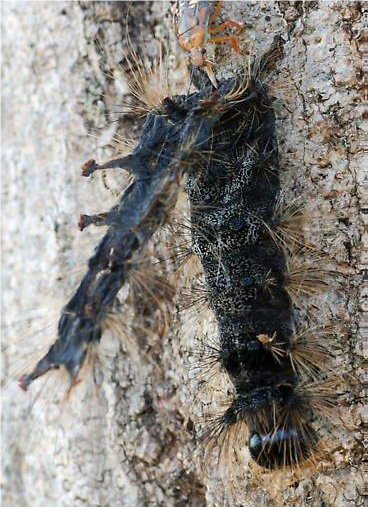
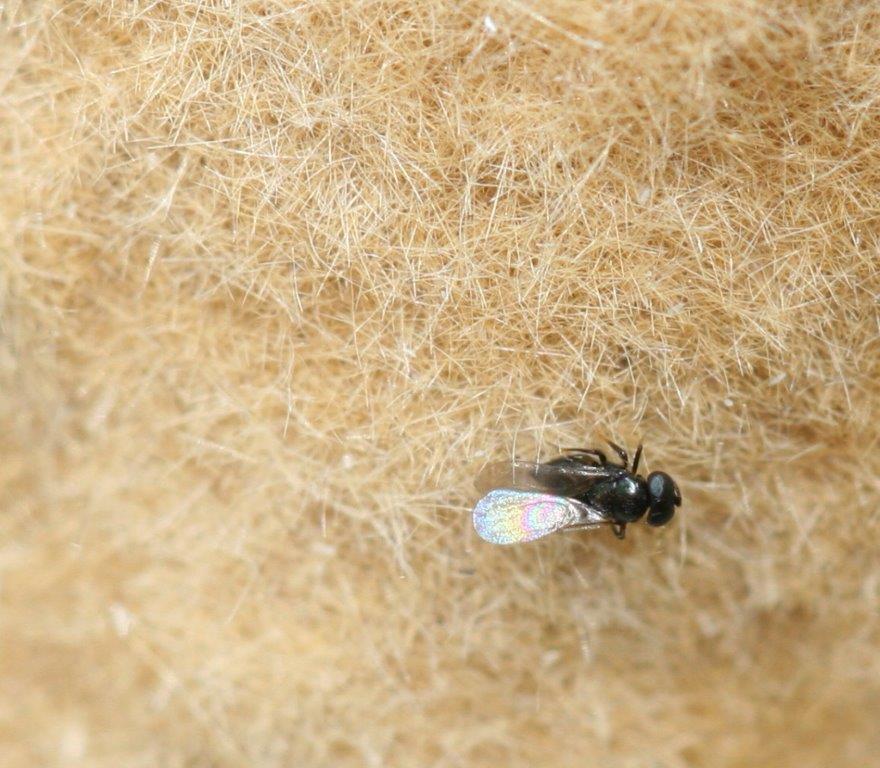
DID YOU KNOW: Maintaining a healthy stand of trees is the best option available for minimizing impacts of spongy moth for forest landowners
Management
There is a range of management options depending on the goals of the landowner, the value of the stand, and its vulnerability to mortality. These are the three principle options for landowners with stands of oak.
Do Nothing and Salvage: Doing nothing is a reasonable option for many woodlot owners. Red oak mortality is not excessive (5-8%) in most stands defoliated by spongy moths. Many owners are willing to accept the risk of mortality and the 5-6 years of growth reduction that occurs. If mortality is significant, salvaging dead and dying trees following the outbreak is always an option. Prompt salvage is recommended because timber values decline significantly due to log degrade; a saw-log tree dead for three years or more is worth very little. Most tree deaths will occur within two years after defoliation, but mortality can occur up to 10 years later. Predicting declining timber values and continued mortality is tricky. Before salvaging, consult with a professional forester for sound advice. UNH Extension maintains a list of consulting foresters.
Cutting Between Outbreaks: A range of cutting practices apply to oak forests, such as intermediate treatments (weeding and thinning) and regeneration cuttings (group selection and shelterwood cuts). All these cutting practices cause stress to stands. Heavy removal of overstory trees (greater than 1/3 of stems) is particularly stressful to the remaining trees. However, with proper cutting the stress is short-lived. It usually takes a stand at least three years to recover following harvest. Ideally, harvestings should be done between outbreaks, and not less than three years before anticipated defoliation. Harvesting also causes some mechanical damage to roots and trees themselves, and may increase incidence of secondary diseases which feed on stumps (such as the rootrot fungus, Armillaria). Harvesting just prior to or during an outbreak will cause higher mortality of overstory trees due to stress, secondary diseases, and increased defoliation due to less available foliage (food) per acre.
Maintaining a healthy stand of trees is the best option available for minimizing impacts of spongy moth for forest landowners. Proper thinning in advance of an outbreak can reduce stand mortality by removing trees in poor health which are most likely to die, and increasing the vigor of remaining trees. Before beginning a cutting operation, consult with a competent professional forester to obtain sound advice on proper harvesting techniques.
Chemical Control: Pesticides can be used to reduce spongy moth damage when applied by ground equipment or aircraft (fixed-wing or helicopter). Ground application is impractical for most woodlot owners because dense forests are not readily accessible. However, ground equipment can do an adequate job on roadside or shade trees. Due to the migration of larvae from unsprayed trees, multiple applications are often necessary. Pesticide applicators must have a Commercial Pesticide License from the NH Division of Pesticide Control (NHDPC). A list of applicators can be obtained from NHDPC or your UNH Extension County Office.
Aerial application of insecticides is a much more complicated procedure than ground spraying. The decision and responsibility for aerial spraying rests with the landowner. The State of NH may provide technical assistance for aerial spraying of forests on private and public lands. In response to environmental concerns, a rigorous protocol must be followed to obtain the necessary spray permit from the NHPDC. This protocol includes: 1) submittal of original and three copies of the completed application to the NHDPC at least 90 days in advance of proposed spraying; 2) a possible public hearing; 3) notification of beekeepers, town officials, and abutters of the intent to spray; 4) mapping in detail of all environmentally sensitive areas within or near the proposed spray area, including but not limited to streams, ponds, residences, buildings and wells; 5) hiring a licensed aerial applicator; 6) adequately marking spray boundaries for the pilot; and 7) a risk analysis to prove there are sufficient egg masses and stand susceptibility to warrant spraying. Spray buffers are required around abutters who do not wish to be sprayed and in many cases, around environmentally sensitive areas (a typical buffer may be 300 feet). The minimum size area practical to aerially spray is 15 contiguous acres.

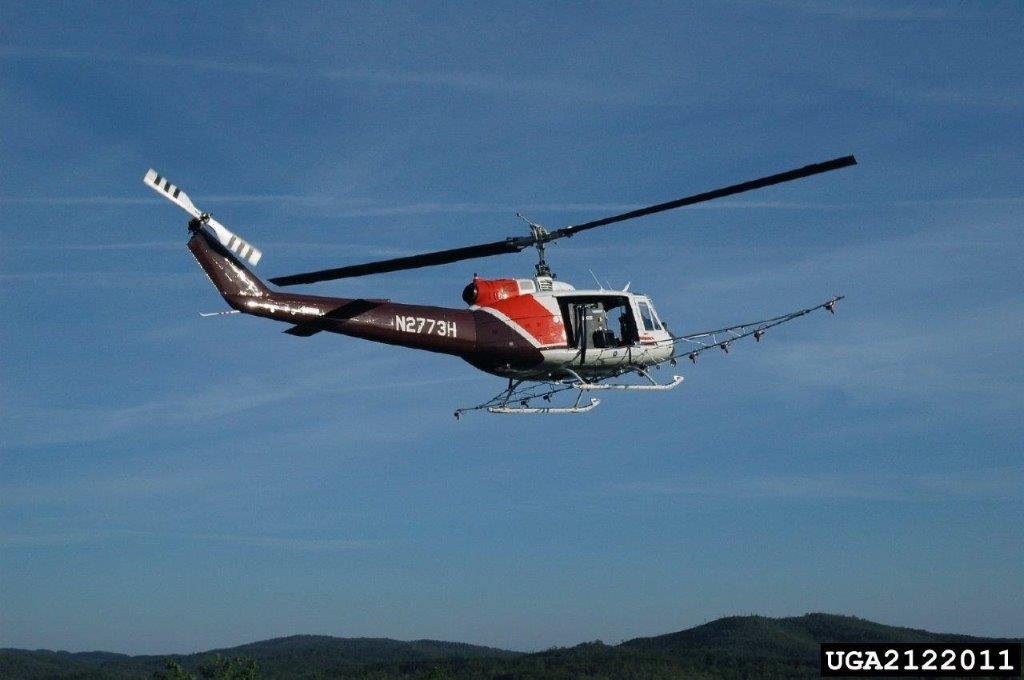
Economic Considerations
Protecting a forest used for its recreational value (e.g. campground) will readily pay back the cost of aerial spraying. It is more difficult to recognize the economic benefit when applied to timber values. Studies performed by the author after the 1981 outbreak showed that growth and mortality losses in sawlog stands of medium quality red oaks exceeded the costs of an aerial application. If you are considering an aerial spray program, consult your UNH Cooperative Extension educator in forestry or another professional forester to discuss the value of the timber and the economic and environmental feasibility of a spray program. Be sure to allow adequate time for planning; you may need six months before the proposed spray date in May.
Environmental Concerns
The safest commercially available pesticides to use for spongy moth control are the biological pesticides using the bacterium Bacillus thuringiensis var. kurstaki (Btk). Btk requires an early season spray application (just after egg hatch) in order to be effective. By the time the larvae reach the third stage (0.4”), the bacterium becomes ineffective. Btk is more expensive but has less residual effect than other insecticides. However, the advantages of using biological pesticides include: 1) least harm to non-target organisms and the environment; 2) less requirement for buffers; and 3) less public opposition. There are several non-biological insecticides that can be used in NH, but because of potential negative environmental impacts, their use is limited and they receive greater public scrutiny.
Integrated Pest Management (IPM): IPM is a term used more frequently as we try to reduce our dependence on pesticides. IPM is the use of a variety of techniques (chemical, biological, physical, and cultural) to reduce pests below economically damaging levels. Biological controls such as parasites and predators cannot prevent or control outbreaks. We need more research to develop effective non-chemical controls for spongy moth.
Therefore, in forestry the primary IPM technique is good silviculture: vigorous well-tended stands are more resistant to economic loss from spongy moth outbreaks. Insecticides should only be used as a last resort, selecting the safest pesticide that meets management objectives. Consult your county Agricultural Field Specialist for specific pesticide recommendations.

damaging levels.
A well-managed woodlot is resilient to spongy moth and other insect infestations. Do not wait for an insect outbreak—start caring for your woodlot today by contacting your local County Extension Forester. Visit www.nhwoods.org for a listing.
Impractical Control Measures for Woodlots: Several control measures are impractical for woodlots:
- Tree Bands - Using tree bands to capture caterpillars may be of some value to an isolated urban tree with low level populations. This technique in a forest situation is useless, as it is impractical to band every tree and only a very small percentage of the larvae would be caught. Many of the petroleum-based sticky products used to repel or capture larvae are in fact harmful to trees and should not be placed on the bark.
- Scraping or Poisoning Egg Masses - In a forest situation, a landowner cannot scrape off or poison enough egg masses to make any practical difference, as most egg masses are in tree crowns or hidden where they cannot be reached. Creosote was once used to paint egg masses but it is now a pesticide restricted by the Environmental Protection Agency (EPA) and by the New Hampshire Department of Agriculture; it is illegal to use for that purpose.
- Fertilizing - Fertilizing forest trees is a somewhat controversial issue. It may be beneficial for individual shade tree vigor. However, the expense and logistical problems render fertilization of forest stands impractical. Furthermore, research on forest tree fertilization is inconclusive, so we cannot currently recommend the practice.
Stop! Read the label on every pesticide container each time before using the material. Pesticides must be applied only as directed on the label to be in compliance with the law. Contact the Division of Pesticide Control at (603) 271-3550 to check registration status. Dispose of empty containers safely, according to New Hampshire regulations.
Acknowledgements
The author expresses appreciation to Northam Parr, UNH Cooperative Extension Grafton County Forest Resources Educator, for his review of silvicultural techniques. He also thanks the NH Forest Pest Advisory Group for helpful comments. The Forest Pest Advisory Group is a multi-agency working committee made up of the Division of Forests and Lands (Department of Resources and Economic Development), Division of Plant Industry (New Hampshire Department of Agriculture), Audubon Society of New Hampshire, US Forest Service and UNH Cooperative Extension. This group advises State officials on forest pest conditions.
Download the resource to see the complete fact sheet.
Lindsay Watkins
lindsay.watkins@unh.edu
(603) 527-5475
Wendy Scribner
wendy.scribner@unh.edu
603-447-3834
12 Court Street, Keene, NH 03431
ce.cheshire@unh.edu
603-352-4550
Ray Berthiaume
ray.berthiaume@unh.edu
603-788-4961
James Frohn
jim.frohn@unh.edu
603-787-6944
Michael Gagnon
michael.gagnon@unh.edu
603-641-6060
Tim Fleury
tim.fleury@unh.edu
603-255-3733
Greg Jordan
greg.jordan@unh.edu
603-679-5616
Lindsay Watkins
lindsay.watkins@unh.edu
603-749-2529
Dode Gladders
dode.gladders@unh.edu
603-863-9200
Steven Roberge
steven.roberge@unh.edu
603-862-4861
forest.info@unh.edu
1-800-444-8978 within New England
603-862-3883
